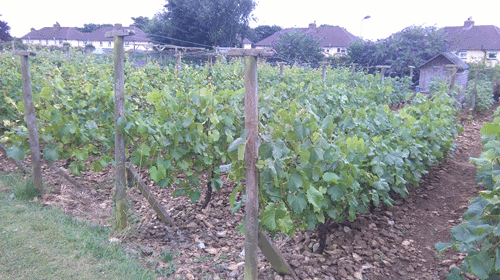


People no longer look at me as if I’m slightly deranged when I say I make my own sparkling wine – or at least not in this country anyway. English wine is fast gaining market space and the sparkling version is even winning blind-tasting competitions in France. I think the fizz I make here in Sherborne, Dorset, is very good and I would challenge you to tell it’s ‘home made’ against any bottle of supermarket-bought Cava, Prosecco or even Champagne.
Sherbubbles is a labour of love involving around 160 vines spread over four adjoining allotments. Some years are good, with a yield of 400+ bottles; others aren’t, with only around 150. The low-yield years often make the best wine.
This is my third year making wine but the vines had actually been imported from France and established by my ‘partner in wine’ some years before. The mastermind behind Sherbubbles is a gentleman with a deep love of wine that upon retirement finally found the time to follow his passion.
Three years ago he suggested I join him in his enterprise and it seemed like a perfect opportunity to get out into the fresh air and learn something different. And I knew what his stuff tasted like.
Looking after 160 vines is time-consuming and hard work. In April maintenance and preparation work begins on the 16 rows of vines, each of which consists of six strands of 30m-long wire hanging on five sets of posts. Each vine is pruned to only two main branches, forming a T that is carefully trained around the lower wires. By August, these slender branches metamorphose into a mass of tendrils growing at an astonishing rate of two inches per day. You can literally watch them grow.
Many hours are spent battling the bush, pruning unnecessary buds, shoots and leaves that could take valuable nutrients away from the grapes and shield the grapes from the fungicidal spray. A spraying schedule outlines when certain chemicals need application and, without them, the grapes would be ravaged by disease or fungus (how often do you see organic British wine?). Spraying is a two-hour process involving vigorous hand-pumping whilst carrying 10 litres of water on your back.
When the grapes begin to take their final form it’s time to put up the nets. Without the nets the birds would decimate the crop, so each row of vines gets a single 30m roll of netting which is then weighed down with rocks on the ground. Incidentally, this being Dorset the rocks often contain fossils from the tropical sea that used to cover the area (the nicest ones are in my garden now).
Finally, at the end of the summer/beginning of autumn, comes the vendage. Once the sugar levels of the grapes are deemed high enough (we have the equipment) the grapes are picked into big rubber containers and cleaned. The harvest can stretch over weeks because the different varieties of grapes (red and white) mature at different speeds. The grapes are then crushed with some serious German engineering in the form of a hand-operated destemmer/crusher machine, and then the resulting pulp pressed until every drop has been collected. It is an exciting time and the smell of the grape juice permeates everything, a lovely promise of what is to come.
Fast forward a few months later, when the wine is ready, the tricky part comes. The bubbles. After yeast and sugar have been added to the wine, it is bottled with a plastic bung and crown cap (much cheaper than corks). Champagne bottles are donated by friends throughout the year and these are de-labelled and disinfected. Cava bottles can be used, but they can’t withstand the pressure as well as Champagne, which can lead to messy, unexpected (and very dangerous) explosions.
The bubbles will take some time to develop and the entire stash is kept in the cellar of my wine partner’s house. Rather handily he lives in what used to be the village dairy, and a small stream trickles through the middle of the cellar floor, keeping the temperature nice and cool.
The final stage is disgorging – taking the lees (sediment) out of each bottle prior to drinking. For this process the bottles are kept pointing downwards and spun daily for a week or so, until all the lees have congregated around the cap. The bottle is then put in the freezer, pointing downwards, until only the bottle neck (containing the lees) freezes. The bottle is carefully opened and the lees explode out, making a mess of the kitchen but leaving behind a clear, dry sparkling wine with a fabulous vanilla taste.
Oh, and before you ask, we don’t sell it. It’s far too good.
Fancy a glass?



